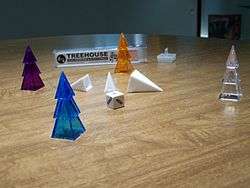Treehouse (game)
|
Initial position showing the House (white) and four players (Xeno colored set) | |
| Designer(s) | Andrew Looney |
|---|---|
| Publisher(s) | Looney Labs |
| Players | 2–4 |
| Age range | All ages |
| Setup time | < 5 minutes |
| Playing time | 5–10 minutes |
| Random chance | High |
| Skill(s) required | Pattern recognition |
Treehouse is a game in which players try to get their configuration of Icehouse pieces to match the central configuration, shared by all players. The rolling of the special "Treehouse Die" tells the player what kind of move to make to change his own or the central configuration, and then he does so to best move towards the goal.
Treehouse was invented by Andrew Looney in 2006 and is sold by Looney Labs. It reflects a change in marketing of Icehouse pieces by Looney Labs, in order to try to improve sales[1] and has become the basis for further marketing of the product. It is sold in two color variants: Rainbow (consisting of black (opaque), blue, red, green, yellow) and Xeno (consisting of white (opaque), purple, cyan, orange, clear). In 2007, Treehouse won the Origins Award for best boardgame of 2006.[2]
Play
To start, each player is assigned three pyramids, one of each size, stacked on top of one another, in a configuration commonly called a "tree". Another trio of neutral pyramids (called the "House") is placed in the center of the table, in a different arrangement. The objective is to arrange your three pyramids to match the house. However, you are only allowed to maneuver your pyramids as dictated by the roll of a special die.
References
- ↑ Looney, Andy (2006-02-09), Looney News, retrieved 2007-08-06
- ↑ 33rd Annual Origins Award Winners
External links
- Treehouse product page at Looney Labs
- Treehouse at BoardGameGeek
